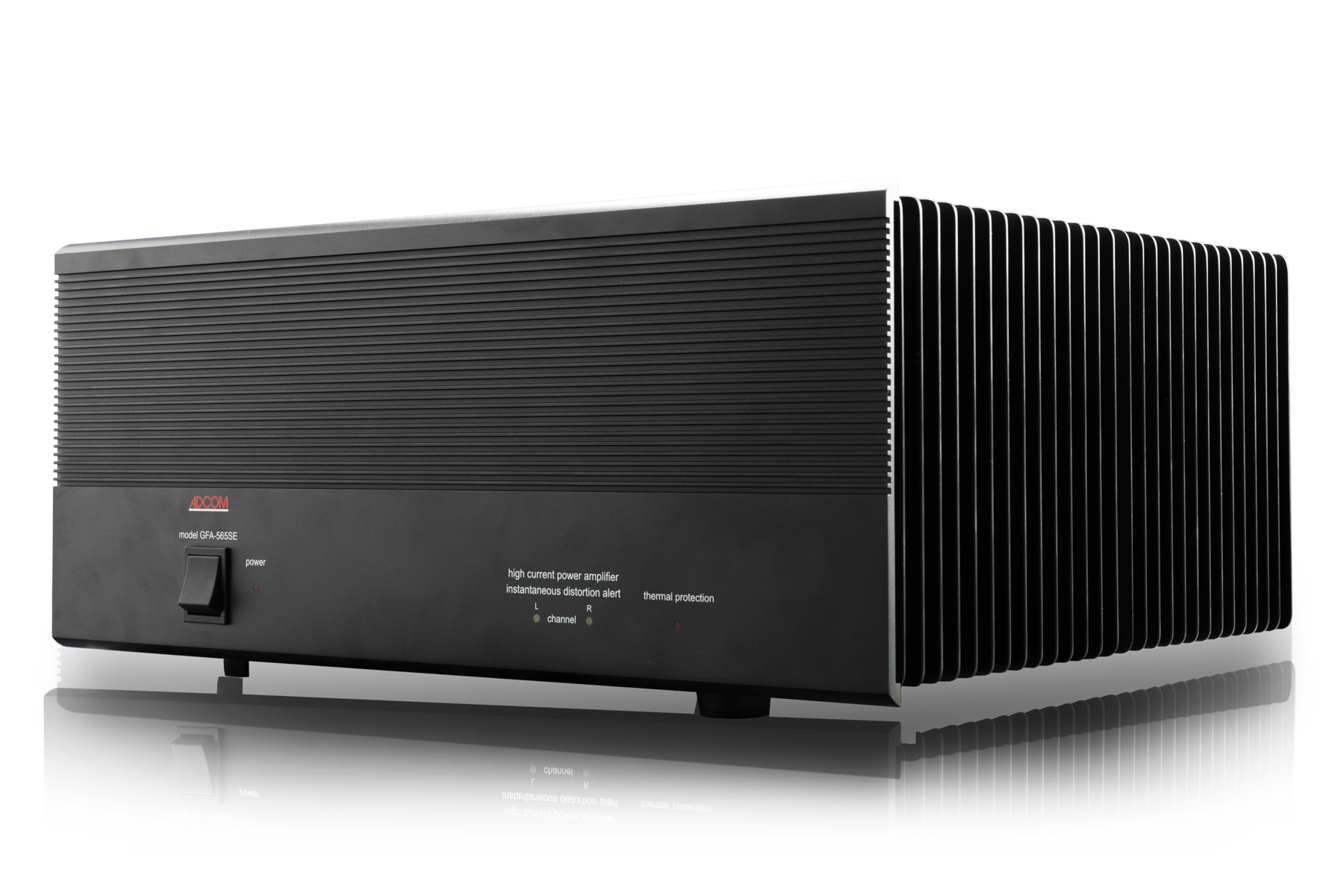What Hi-Fi? Verdict
You are not going to be able to buy any modern hi-fi stereo power amplifier for anything even close to what Adcom is asking for the GFA-585se. Its high power output, incredible sound a low noise belie its low asking price.
Pros
- +
High power output
- +
Great sound
- +
Low noise
Cons
- -
Lack of protection circuitry
Why you can trust What Hi-Fi?
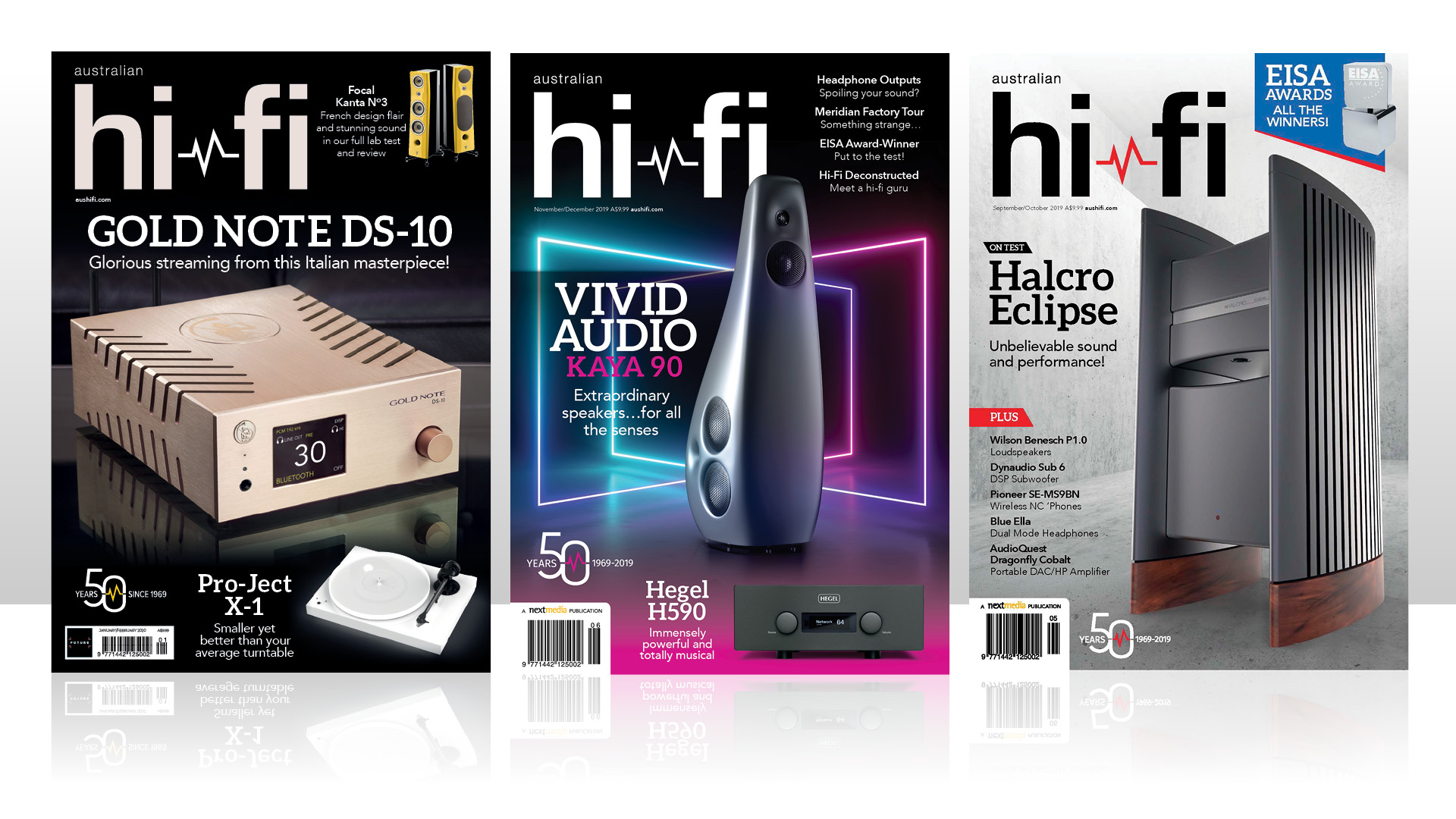
This review and test originally appeared in Australian Hi-Fi magazine, one of What Hi-Fi?’s sister titles from Down Under. Click here for more information about Australian Hi-Fi, including links to buy individual digital editions and details on how best to subscribe.
You’ve heard that apocryphal saying “They don’t make ‘em like they did in the old days”. These days that certainly applies to amplifiers, with even the glitziest of the uber-hi-end amplifier manufacturers succumbing to the temptation of just buying ‘off-the-shelf’ Class-D modules from Denmark or Holland and putting them inside their amplifiers.
Well I can use these pages to tell you that, at least when it comes to Adcom, they “do make ‘em like they did in the old days” because the Adcom GFA-585se looks like it just arrived on a time machine straight from the 1980s. Same circuitry, same build quality, same construction techniques… even the same look.
It’s a high-powered, Class-A/B ‘muscle’ amplifier of the type that once shared shelf space in hi-fi emporiums with the likes of other famous ‘muscle’ amps of the day – Sumo, S.A.E., Crown, Great American Sound Company, Krell and others.
Adcom is no longer manufactured in the USA (see later in this review under the heading Adcom history) but the new owner owns all the original schematics and, with the GFA-585se at least, seems to be following them to the letter.
Equipment
Like Everest, photographs of the Adcom GFA-585se cannot prepare you for the sheer size of this amplifier. And they certainly can’t prepare you for the amplifier’s weight. So far as size is concerned, your rack (or, more likely, floor) is going to have to accommodate dimensions of 275 × 482 × 502mm, so it’s around half a metre wide, and half a metre deep and so high you could use it as a foot-stool. It weighs 32kg.
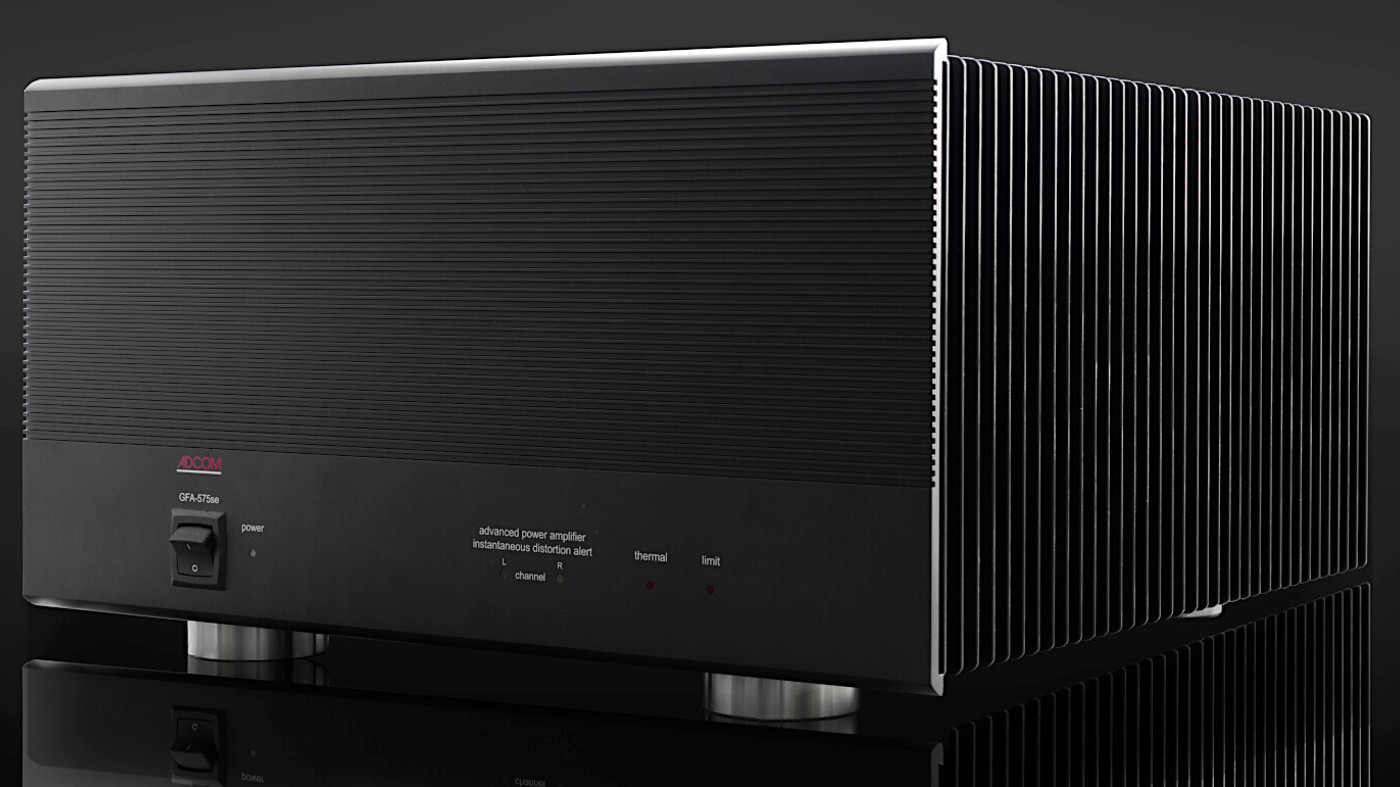
Photographs also don’t do the Adcom GFA-585se’s front panel justice, because it’s nigh-on impossible to convey the “shine” and the depth of black of all that fluting. So if you think it looks good in the photographs, just wait until you see it in the flesh!
I guess that in one way it’s lucky the front panel looks so good, because there’s so much of it on display!
There certainly isn’t much on the front panel but I wouldn’t expect much on a power amplifier. I was pleased that the mains power switch is on the front panel, where it’s easy to access, but in fact you probably won’t need to use it all that much because you can configure the circuitry so that the amplifier will go into stand-by automatically, in which mode it will draw less than one watt.
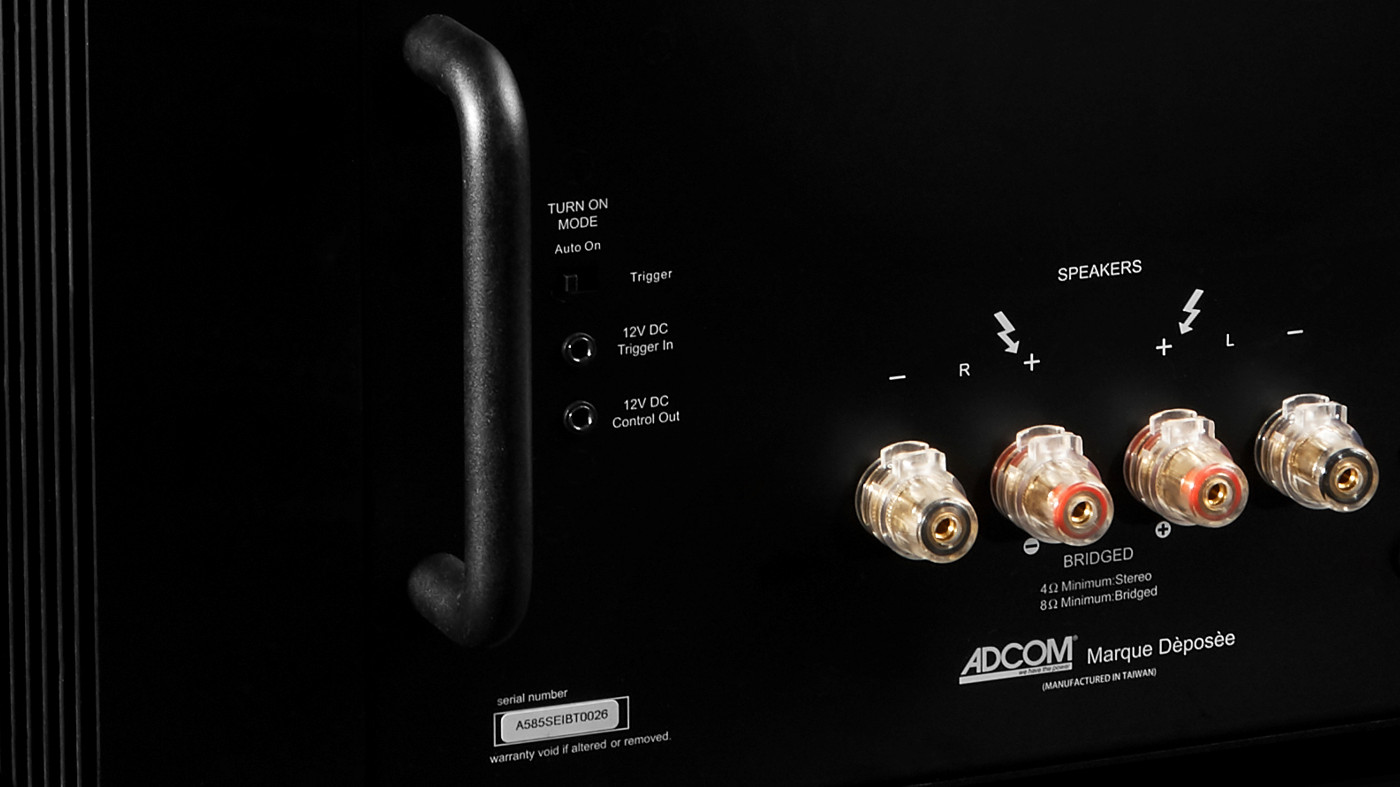
It does this via an auto-sensing circuit that switches the amplifier on automatically when it senses an audio signal at its input, and off when it has not detected a signal for a period of time. The amplifier can also be switched on and off via an external trigger voltage. If you’re not a fan of auto-sensing circuits or trigger voltages, you can also set the amplifier for totally manual operation, in which case the front-panel location of the power switch will prove to be very handy.
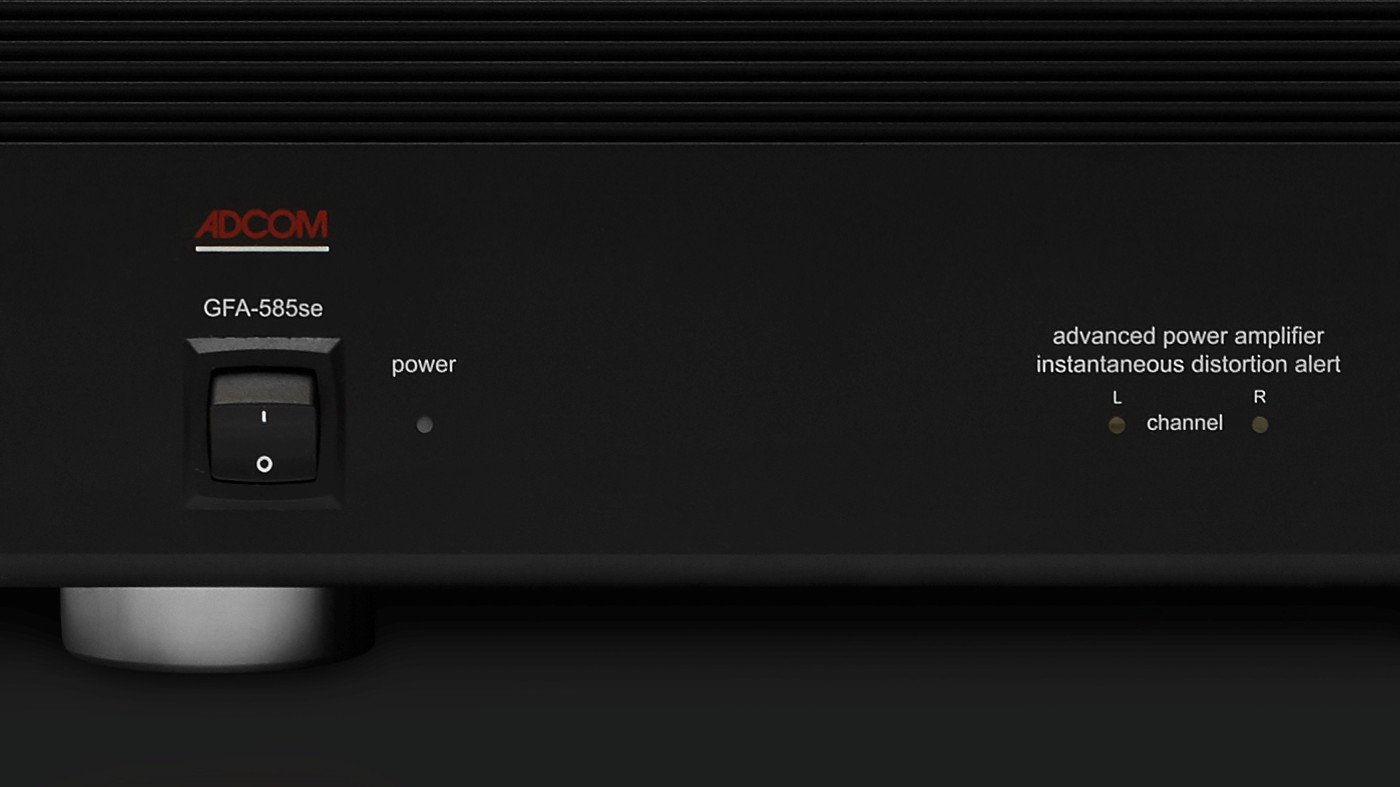
It’s pretty hard to miss the two LEDs to the right of the power-on LED, because they have the longest identification name I think I’ve ever seen on the front panel of any amplifier… ever. You’ll probably be able to see it in the photographs accompanying this review, but if you can’t, the writing says ‘advanced power amplifier instantaneous distortion alert.’
I think I would have labelled these LEDs with something a whole lot shorter and simpler, such as ‘Headroom Alert’ or ‘Peak Power Indicator’.
I am pretty sure that the underlying circuit is a fairly straightforward clipping detector, but Adcom says of it: “The instantaneous distortion alert circuit is a unique ADCOM distortion-detection system which reads all forms of non-linear distortion such as THD, IM, slew-induced, ‘clipping’, etc. The instantaneous distortion alert LEDs will light when distortion reaches 1% regardless of the impedance or the phase angle of the current voltage and the reactance of the loudspeakers which the amplifier is driving.”
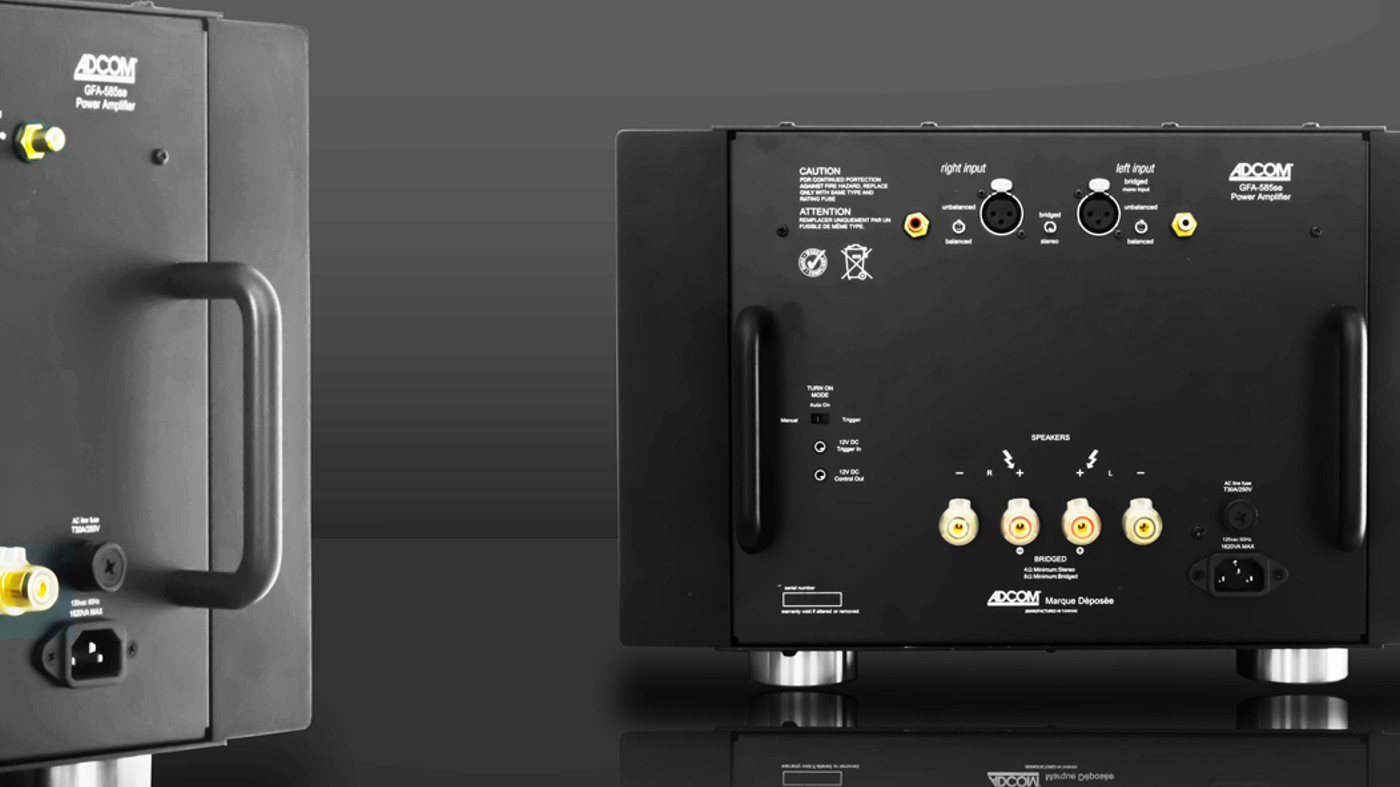
It goes on to say: “Sometimes, when the amplifier is in use, the LEDs may occasionally flicker under high-volume listening, particularly if you are driving low impedances. This flickering is no cause for concern. The LEDs are simply warning you that the amplifier is approaching its maximum power output into the specific loudspeakers which you are using.”
However, there’s more of a warning to follow: “If, however, the instantaneous distortion alert LEDs glow brightly or are on most of the time during playback, you are overdriving the amplifier and should lower the volume control to reduce the listening-level demands, or you may blow the AC rail fuses, cause the thermal protection to be activated or, in extreme cases, damage your loudspeakers.”
As you can see from this description, the Adcom has thermal protection circuit, which it says will ‘shut down the amplifier if the temperature of either heat sink reaches 70°C.’ If this happens, the LED labelled ‘thermal’ will illuminate and the output stage will be disabled until the temperature of the heat sinks drops below 70°C, after which the amplifier will automatically re-connect the output stage and playback will continue.
To the right of the ‘thermal’ LED is an LED labelled ‘limit’. You’ll see this turn on for around ten seconds whenever you switch the amplifier on while the circuitry stabilises after which you’ll hear a pair of relays click and the amplifier will be ready for use.

Adcom’s ‘Owner’s Manual’ says that the “the GFA-585se is provided with an overload protection circuit to protect amplifier when speaker short circuit (sic) or DC voltage is happened (sic) on the amplifier output stage… it means the output relay will open immediately to prevent the output transistor or other parts from failing.”
The issue I have with this statement is that I doubt any relay could operate quickly enough to provide this type of protection, and relying on a fast fuse would also be unwise with such a high-powered amplifier. Indeed the local Australian distributor, CIS Allure, says that users should never make any changes to input or output connections while the amplifier is turned on and under no circumstances should the speaker terminals be short-circuited or either of the speaker terminal(s) be connected to ground.
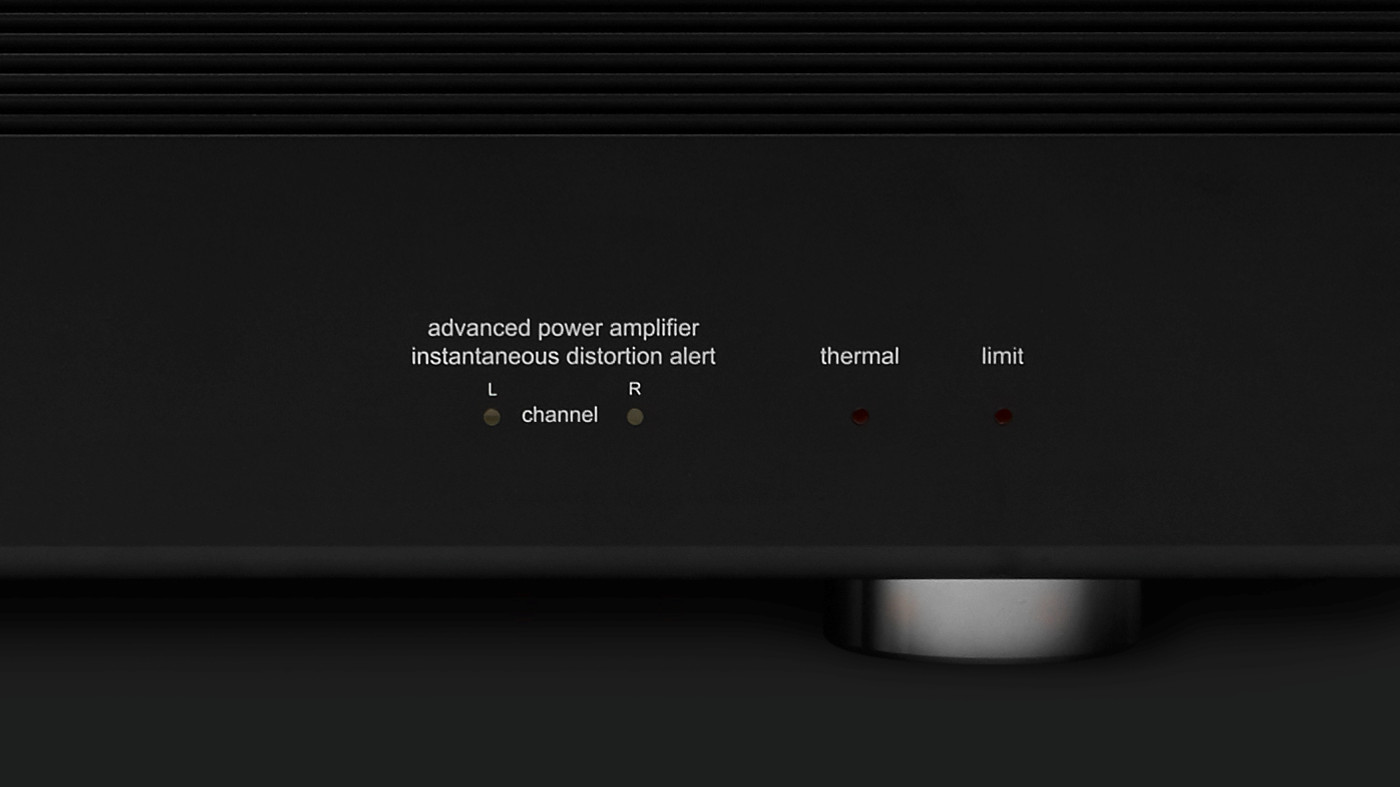
You should note that ‘switching off’ the amplifier is not quite as simple as pressing the front panel switch, or even turning off the amplifier at the mains, because the storage capacitors inside the GFA-585se are so large that the amplifier will continue to be ‘powered-up’ for many minutes after you’ve done either operation.
Indeed Adcom provides a very large warning (highlighted in bold type) right at the start of its Owner’s Manual which says: “WARNING. The GFA-585se is a very powerful amplifier capable of delivering very large peaks into low impedances, exceeding 50 amperes per channel. Therefore, be certain to exercise extreme caution when making connections to and from the amplifier."
"Always make certain that the amplifier is disconnected from the AC outlet, and its large filter capacitors are discharged. Please note that the power supply capacitors can take more than 12 minutes to discharge. Failure to observe this precaution may result in damage to the loudspeakers and/or blowing of the amplifier's a.c. rail fuses, conditions which are NOT covered by the warranty.”
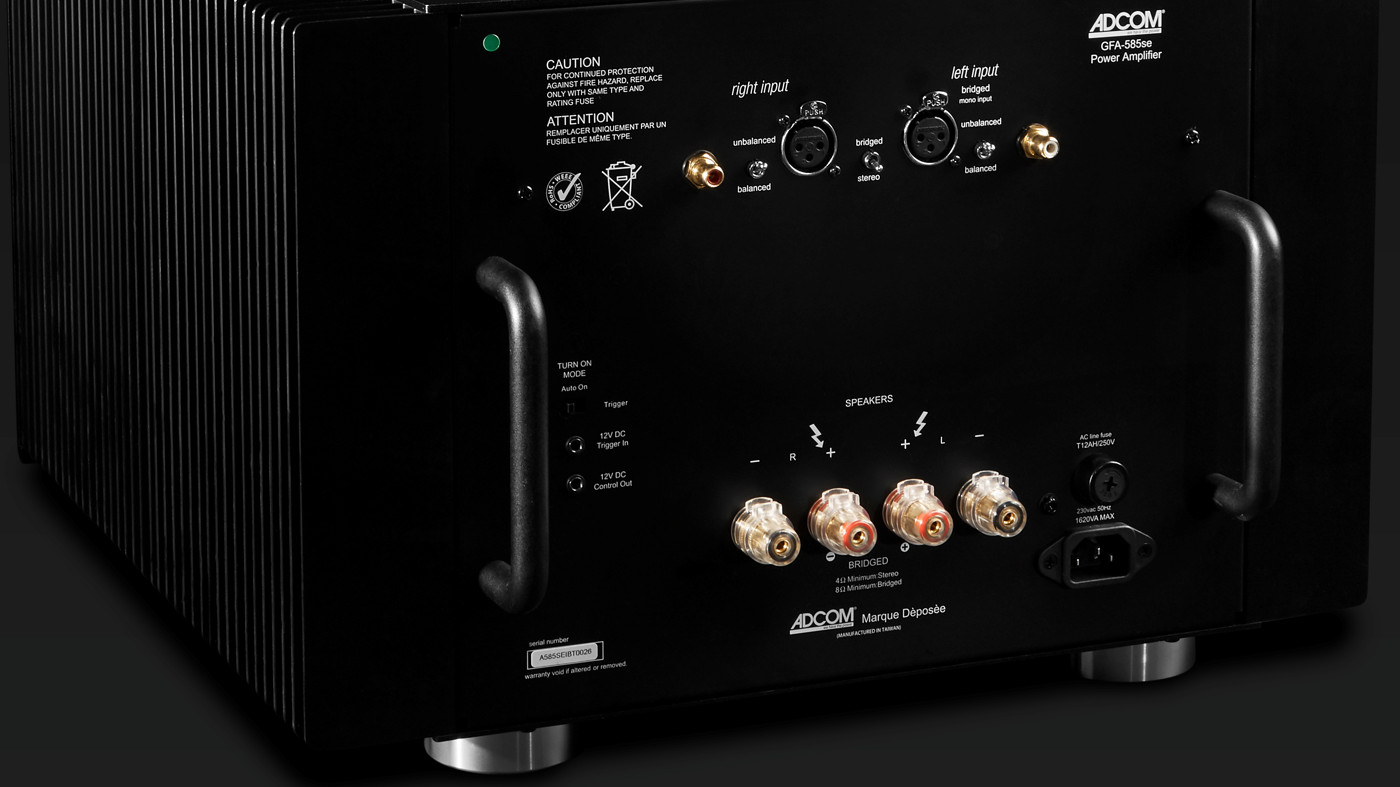
The rear panel has both unbalanced (via gold-plated RCA terminals) and balanced (via gold-plated XLR terminals) inputs, with two micro-switches (one for each channel) to select the pair you want to use.
There’s also a micro-switch with positions for ‘bridged’ and ‘stereo’, revealing that it’s possible to operate the Adcom GFA-585se as a mono amplifier, in which case its rated output increases to 1,000-watts into 8Ω. As noted earlier, none of these switches should be used while the amplifier is powered-up. (If used as a mono amplifier, the GFA-585se should only be used with passive loudspeakers).
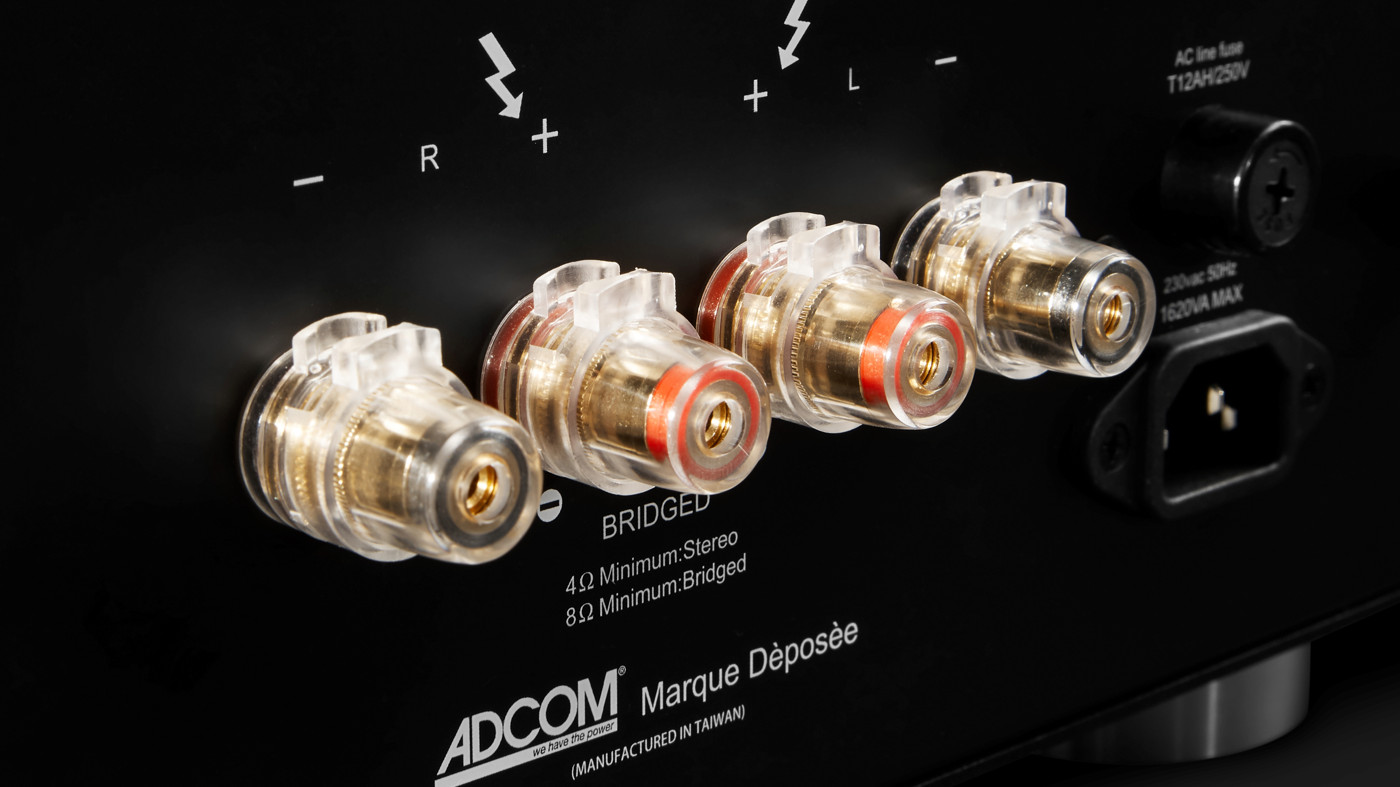
At the left of the rear panel are a slider switch to select turn-on mode (Manual, Auto-On, Trigger) and the two 12V d.c. trigger terminals (in/out). The speaker terminals are large, well-made, insulated multi-way types, with the channels oriented correctly so your speaker cables will not cross. Below the terminals are advisories about the minimum speaker load that can be accommodated (4Ω when the amplifier is in stereo mode and 8Ω when it’s in mono mode).
There are two large handles on the rear panel to facilitate moving it, but the weight and the fact that the huge toroidal power transformer is positioned off-centre, behind the front panel, along with the 34kg dead-weight of the GFA-585se, make moving it a job for at least two people.
Adcom history
In L. Frank Baum’s novel The Wizard of Oz, Dorothy famously says, “Toto, I've a feeling we're not in Kansas anymore.” So maybe it should not come as a surprise for you to learn that Adcom is no longer headquartered at 11 Elkins Road, East Brunswick, New Jersey and has not been there for nigh-on half a century. Since it was first established back in the 1970s in the USA, the company has shifted through different states of America, and though several completely different owners, who between them had varying degrees of success with the brand.
The company was founded by Newt Chenin, who was the Southern Californian sales representative for one of the most famous amplifier companies in America, SAE (Scientific Audio Electronics), founded in 1967, in Los Angeles, by Morris Kessler and Ted and Beth Winchester. The SAE amplifier circuits were designed by Kessler himself, as well as by Ed Miller (who would later found Sherwood) and James Bongiorno (whose designs were used by Marantz, Dynaco, Sumo, Great American Sound, Harman-Kardon and Spread Spectrum Technologies, amongst others).
Legend has it that Kessler had over-estimated demand on one of his SAE power amplifiers and had a warehouse full of them that he couldn’t shift, so he offered them to Chenin who in addition to being a sales rep, was selling his own line of phono cartridges, under the name Adcom. The brand-name was apparently code for ‘Added Compensation’ because Chenin was making additional income by selling the cartridges to hi-fi dealers he was already visiting on behalf of SAE.
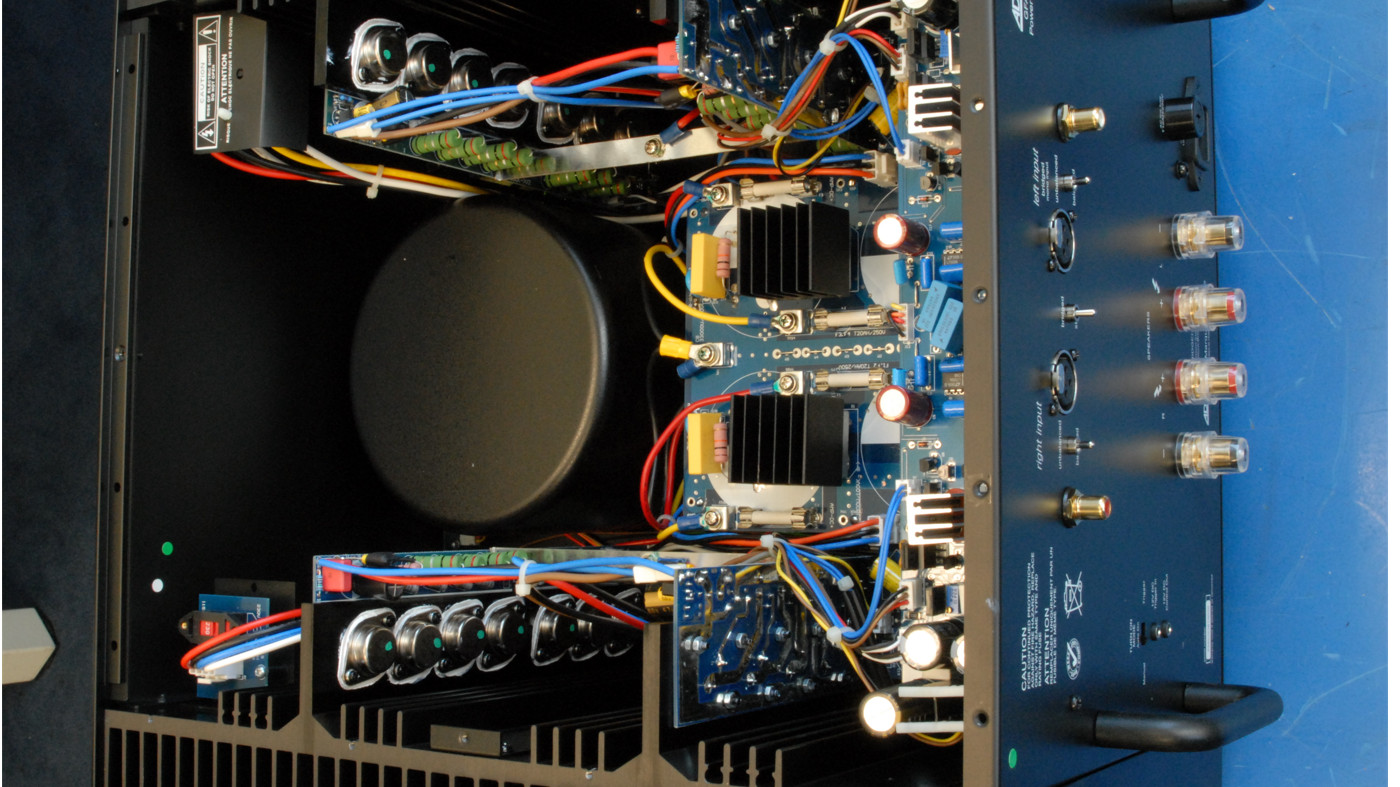
Chenin and Kessler came to an agreement, and the amplifiers were re-badged with the Adcom brand and the model number GFA-1 and released in December 1979. Chenin used the same sense of humour he’d used to create his company name to create the model number for the first amplifier to wear an Adcom badge, because GFA stood for ‘Great F*cking Amplifier’. He later followed it up with the GFA-1A and GFA-2 power amplifiers, the GFP-1 preamplifier, and the GFT-1 tuner.
All these models were built by Amplifier Technologies Inc. (ATI), a company owned by Kessler which had a 50,000-square-foot plant in southern California, and built models not only for SAE and Adcom, but also for B&K, BGW, CAT (California Audio Technology), Outlaw Audio, Theta Digital, and a number of others. Kessler sold SAE to Drew A. Kaplan (DAK) in 1988, but kept ATI.
Rated at 200-watts per channel, the Adcom GFA-1 was one of the first ‘high-current’ amplifiers available. It was quickly followed by the GFA-1A power amp and then the GFA-2 power amplifier, establishing a pattern that would become a tradition at Adcom: releasing a specific model, then very shortly afterwards releasing a revised, updated version of that model. All these Adcom models were also designed either by Morris Kessler, Ed Miller or James Bongiorno.
The success of these Adcom models caused Chenin to hire industry veteran Rob Ain as Vice President. When Chenin retired, his son Alec took over the running of the company, and he and Ain brought in Nelson Pass to design the Adcom GFA-555. (After having worked at Adcom since 1981, Ain moved to Polk in 1988, but came back to Adcom as Executive Vice President in 1991, before moving over to Boston Acoustics in 2003.)
The Nelson Pass-designed Adcom GFA-555 power amplifier, released in March 1985, quickly became the company’s most famous model. Indeed it could fairly be said that it was phenomenally successful for the company, with Stereophile reviewer Anthony Cordesman writing of it at the time: “It is so clearly superior to past amplifiers in the low-to-midpriced range – not to mention most amplifiers costing two to three times its price – that I can unhesitatingly recommend it for even the most demanding high end system."
True to form, Adcom released a GFA-555II fairly soon after. Although this amplifier incorporated various circuit improvements, not the least of which was re-instating the original driver transistors specified by Pass (his original design specified Motorola MJE15030/31s, but when Adcom built the 555, they used 2SA1011/2SC2344 drivers only to find these failed if the speaker protection fuses failed. They then went with 2SB633/2SD613 pairs – which also proved problematical – before reverting to Motorola MJE15030/31s), but the main difference was in the exterior.
The original GFA-555 had a very dated front-panel design, with a flat piece of alloy, and rudimentary handles. The MkII version eliminated the handles, added fluting and in general informed the front panel cosmetics that Adcom uses to this day. As for the GFA-585se, although it bears a similar model number to the GFA-555, Nelson Pass says that he “does not recognise the GFA-585se as being related to my original design [for the GFA-555].”
As for the current owner of Adcom, the brand name is now owned by the Everest World Company Ltd., a company based in Bangkok, Thailand, which purchased the rights not only to the Adcom name but also the rights to Adcom’s intellectual property, including its circuit designs.
Everest subcontracts the manufacture of the Adcom GFA-585se – along with several other of its amplifiers – to Resonance Electronics, a company established in 2009 in New Taipei, in Taiwan, that – according to its Facebook page – “specialises in the development and production of power amplifiers, stereo preamplifiers, digital-to-analog converters, and stereo integrated amplifiers for high-end hi-fi audio systems.”
However, although some Adcom amplifiers are built in Taiwan, others are not. The Adcom GFA-5500, for example, is built for Everest by China-based company Quality Technology Electronics.
Listening sessions
You obviously need to exercise some caution when installing the GFA-585se by making sure there is no common ground between the input and output, following the warnings in the instructions never to make any change of input or output connections while the amplifier is turned on, and avoiding short-circuits of any kind, but these are no more than you should do when installing any hi-fi amplifier at all. I really only mention it because we’ve probably all become so used to super-sophisticated computerised modern protection circuits – which you won’t find these inside the GFA-585se – that we can let our guard down sometimes.
I thought I’d start my listening sessions with a biggie, and one with which I’m more than familiar, Handel’s mighty ‘Messiah’, which here in Australia we tend to perform around Easter (when it was intended to be performed), whereas in the rest of the world it’s more often performed around Christmas. I consider it one of the miracles of high fidelity that I can listen to it any time I like. It’s very long (the score runs around 300 pages!) and when following using the score (which I often do) I am continually amazed that Handel composed it in just 24 days.
To give you an idea of how fast Handel would have had to have been putting pen to paper in order to do this, Miles Hoffman, Professor of Chamber Music at the Schwob School of Music, once estimated if Handel had been composing 10 hours a day, he would have had to put down 15 notes every minute! (Though I am not sure if Hoffman took into account that many parts of the Messiah are recycled from works Handel wrote earlier.)
Listening to a performance recorded at the Sydney Opera House just a few years ago (in December, for a change), I didn’t need to listen for long to hear that the Adcom GFA-585se was doing a superb job in ‘telling it like it is’, because it sounded exactly as I recalled when I was in the audience the night it was recorded. When the massed choir (600 strong) comes in singing ‘and the glory, the glory of the Lord’ I thrilled as the shivers went down my spine, particularly at the gloriously beautiful sound of the sopranos.

The acoustic of the Sydney Opera House is particularly kind to sopranos, which I heard immediately when Celeste Lazarenko took her first solo with Shepherds, where I could hear not only her voice direct, but also the faint echo from the rings above the stage and also the louder echo from the hall itself – at least I could when listening to the Adcom GFA-585se.
It’s not always this evident. I admired, too, the accuracy with which the Adcom rendered the sound of the harpsichord (which is given a rightful prominence in this recording that it’s not often given).
The Adcom also delivered the famous Hallelujah chorus with aplomb and was equally superb at delivering the triumphant sound of the final Amen, the sound of which I confess I prefer over the Hallelujah.
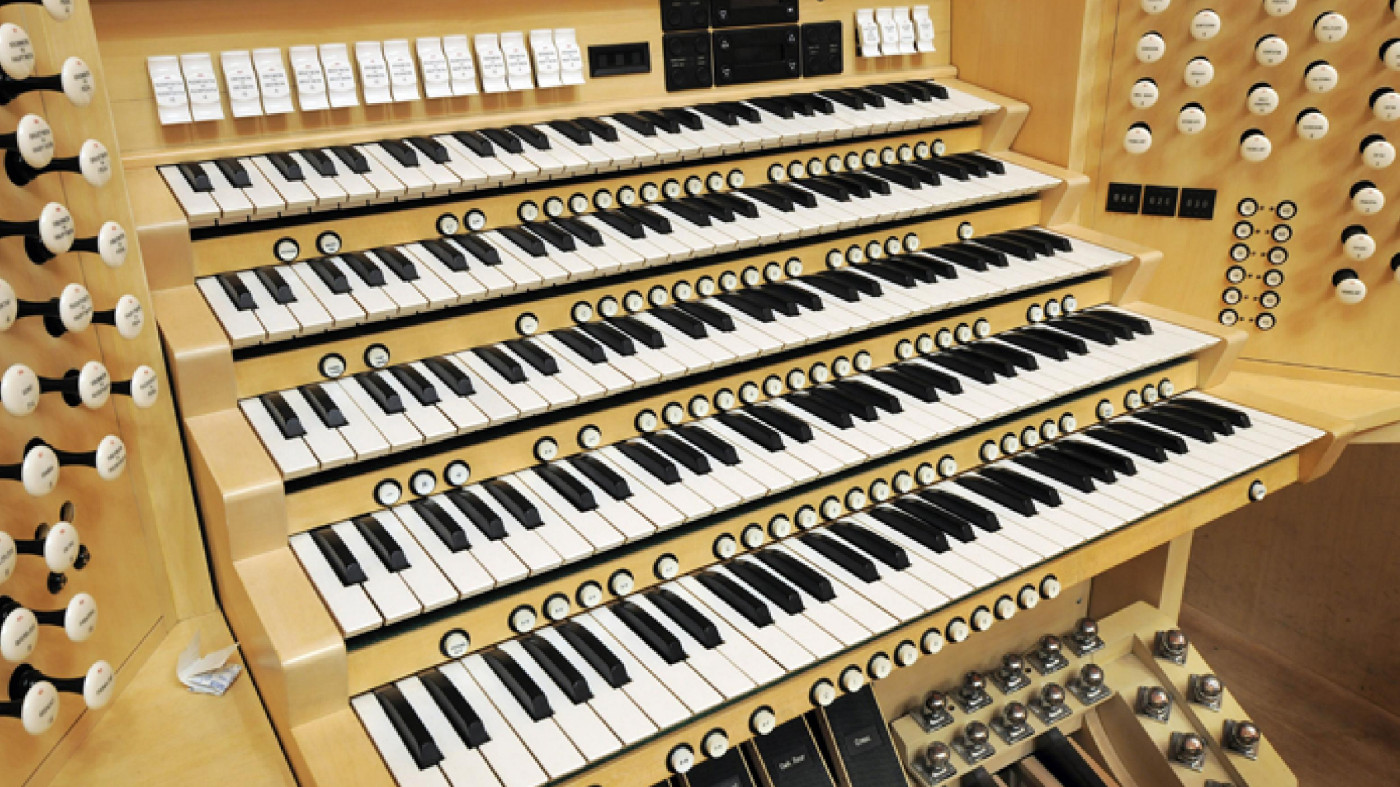
Sydney’s Opera House is not only one of the most beautiful in the world, it also houses the world’s largest mechanical action pipe organ, with 10,244 pipes, 201 pipe ranks, 131 speaking stops and five manuals. I heard its sound being authentically reproduced during the Messiah, but I heard it much better when I switched to playing a fabulous recording made by Move back in 1969 shortly after the Sydney Opera House was opened.
Appropriately titled ‘Sydney Opera House Concert Hall Grand Organ’ it features Douglas Lawrence, Robert Ampt, Christa Rumsey and Donald Hollier demonstrating the organ’s versatility playing works that you really wouldn’t expect, such as Grand Chœur from 12 Pièces (Théodore Dubois), a Lamento and a Litany (Jehan Alain), Preludes for Christmas Time: Op. 76, No. 6 (Schiedermayer) as well as some you might, written by Lizst, Hayden and Schumann. What? No Bach? No, but there is Lizst’s absolutely stunning tribute to him – Prelude and Fugue on B-A-C-H – which on this disc is magisterially rendered by Hollier.

The Adcom delivered the awesome sound of the organ’s larger and longer pipes tremendously well, while also accurately voicing the multitude of stops used to showcase the instrument’s versatility. You can hear that the Adcom doesn’t have any inherent circuit noise, either, because when Move’s engineers let the sound of the organ fade away at the conclusion of the various works, you can hear the acoustic of the Opera House itself.
Curiosities on this album are several of Haydn’s Pieces for Mechanical Clock, played by Robert Ampt. When I first heard this album I had no idea that there were once clocks that, instead of ringing to indicate the hour (or parts of it) instead were connected to small (tiny!) mechanically-operated pipe organs, and played them instead.
Various composers were commissioned to write pieces that these clocks could play and many – including Haydn – obliged. Beethoven did. Even Mozart did, but he wasn’t happy about it, telling Constanze in a letter: “If it were on a large clock-work with a sound like an organ, I’d be glad to do it; but it is a thing made up of tiny pipes only, which sound too shrill and childish for me.” Needless to say, Hayden’s pieces, as rendered by the Opera House organ, are neither shrill nor childish. And they sound wonderful.
I’d been turning up the volume quite a bit, and finding the Adcom GFA-585se was easily and effortlessly delivering the power levels I required, but my home isn’t really suited to massed choirs and pipe organs, so I thought I’d turn the wick to max playing back an instrument my home is suited to, in the shape of a piano. And if you want to hear a piano hammered mercilessly, I can’t think of a better track than Muse’s Apocalypse Now, the opener to 2003’s ‘Absolution’.
The power available on tap from the Adcom GFA-585se is more than impressive – it’s awe-inspiring. And it’s audible not just with the piano sound, but with the swirling synthesisers, the frantic drumming and the urgent bass on this track. Part of the lyric of this song is “Declare this an emergency/come on and spread a sense of urgency… this is the end/the end of the world.” And in this case the lyric would be right. Turn up the volume on this one with the power levels the Adcom GFA-585se can deliver and it really will sound like the end of the world!

But the Adcom GFA-585se can also be soft, silky and delicate, as I proved to my satisfaction by listening to Karen Carpenter sing Burt Bacharat’s (They Long to Be) Close to You. She was a great drummer, but it’s her voice that always amazes me, because it’s just so, so pure yet has a tonal depth the like of which I don’t think I’ve heard since.
In some ways it’s a pity that the Carpenters’ hit songs Close to You and We’ve Only Just Begun and I’ll Never Fall in Love Again are so bubble-gummy, because it means that few listeners might take the time to listen to their excellent Beatles covers, their great version of Leon Russell’s A Song For You, or to Karen’s version of Don’t Cry For Me Argentina which, although it’s not perfect for her register, beautifully demonstrates the perfection of her phrasing and breath control. Although this was one of four hits from the album ‘Passage’, my favourite on this album is their cover of Klaatu’s Calling Occupants of Interplanetary Craft.
Verdict
My alternate idea for the lead paragraph to start this review was to introduce the Adcom GFA-585se as ‘a blast from the past’ because in terms of its electronic design, its build quality, its sound quality and even its appearance, it’s like a time-traveller from the 80s. Which is good news because to my mind, the power amplifiers from that period represent the ‘golden age’ of high-end audio. But that’s just the good news.
There’s even-better news, which is that it would appear that the recommended retail price of the GFA-585se has also travelled through time to 2021. You are not going to be able to buy any modern hi-fi stereo power amplifier with the same high power, low noise and distortion and extended frequency response – or its superb sound quality – for anything even close to what Adcom is asking for the GFA-585se.
In-depth laboratory test report
Newport Test Labs measured the both-channels-driven into 8Ω power output of the Adcom GFA-585se as a just a few watts shy of 500-watts per channel (496-watts), which is above specification. Importantly, it is able to deliver this power at any frequency across the audio spectrum, from 20Hz to 20kHz, as you can see from the tabulated figures and the graph below.
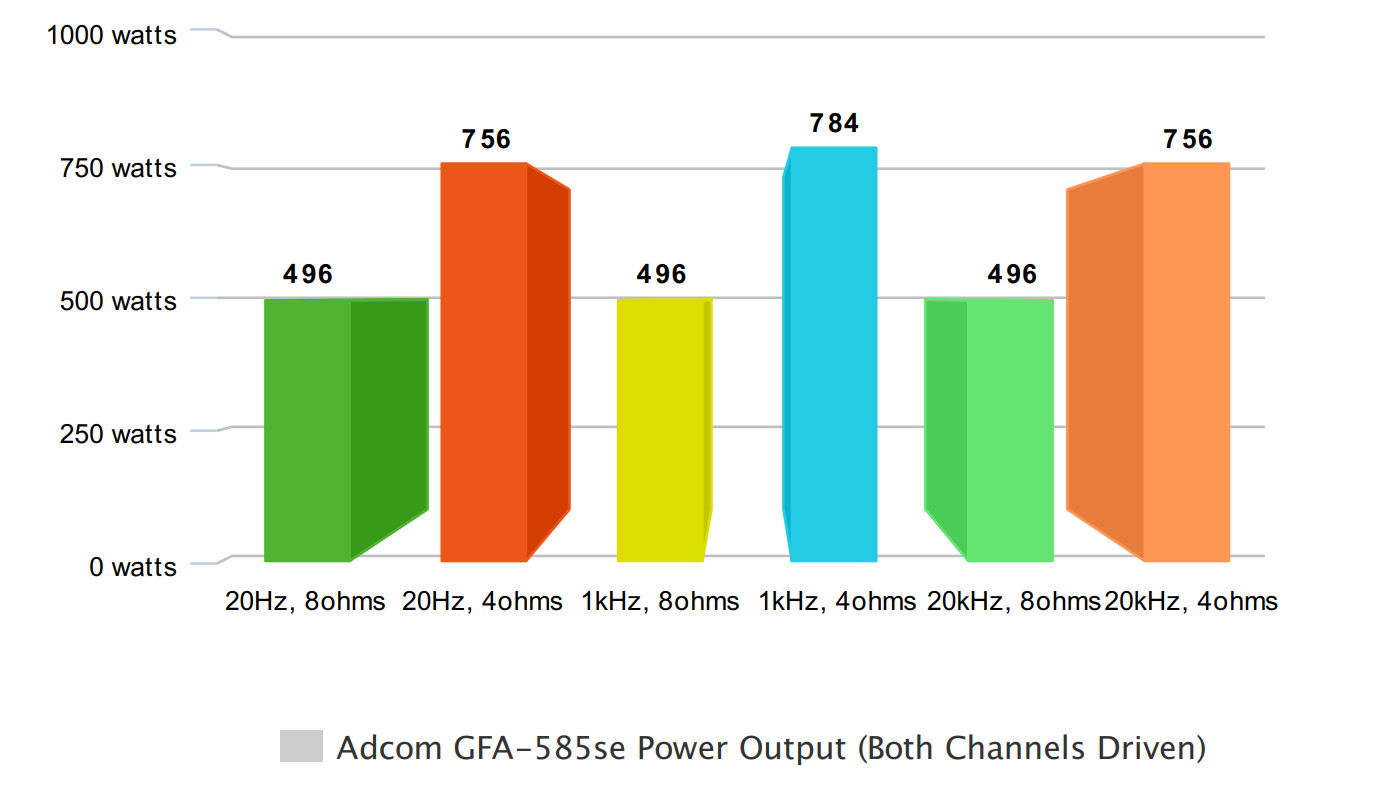
When only a single channel was driven into the same load, the GFA-585se’s output power increased to 530-watts per channel at the frequency extremes, and to 545-watts per channel at 1kHz. A graph showing this is below:
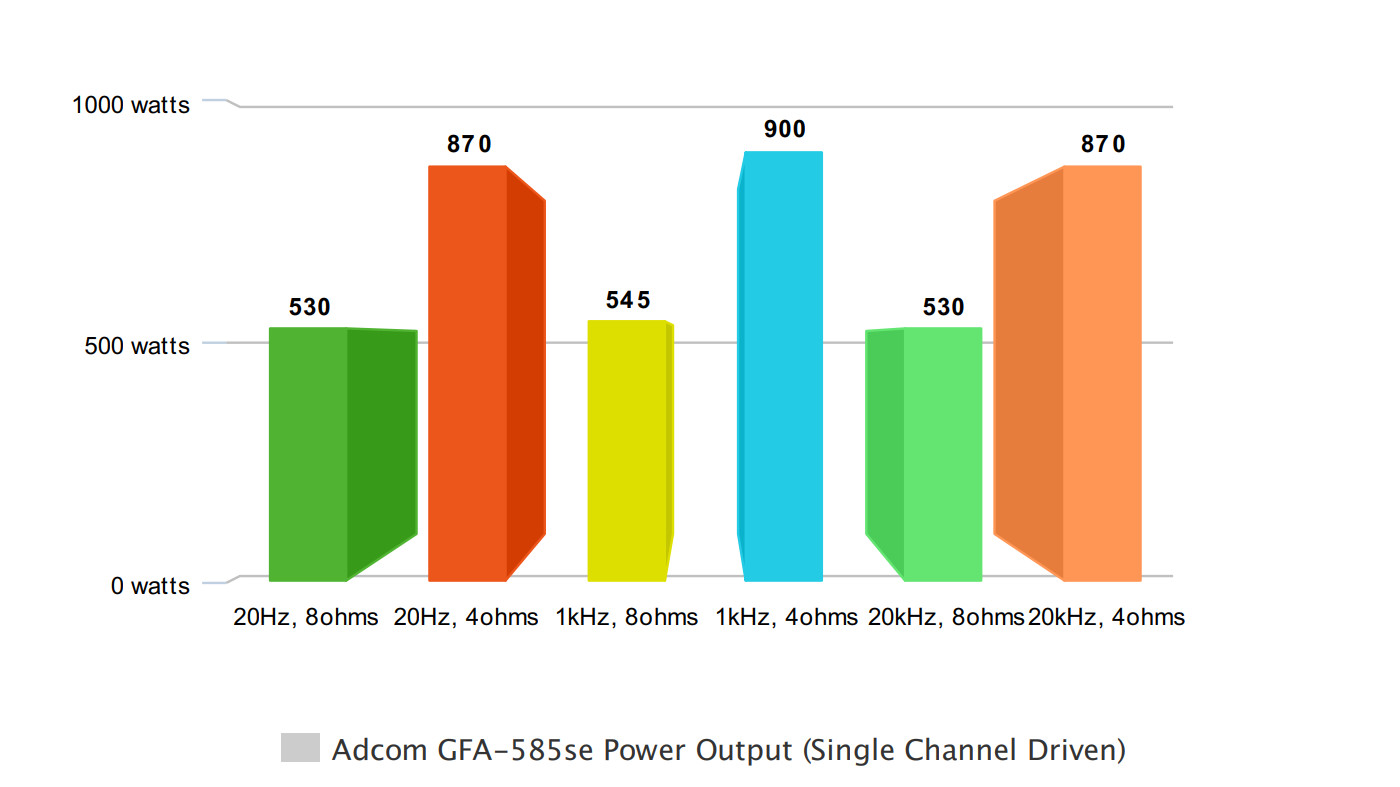
Driven into 4Ω loads, Newport Test Labs measured power output at 784-watts per channel, both channels driven, using a 1kHz test signal, and 756-watts per channel, both channels driven, at the ends of the audio spectrum – 20Hz and 20kHz. Again, these figures are higher than Adcom’s specification of 600-watts per channel.
When just a single channel was driven into 4Ω, Newport Test Labs measured power output at 1kHz as 900-watts per channel, and at 20Hz and 20kHz as 870-watts per channel. These outputs are also shown on the graphs above.
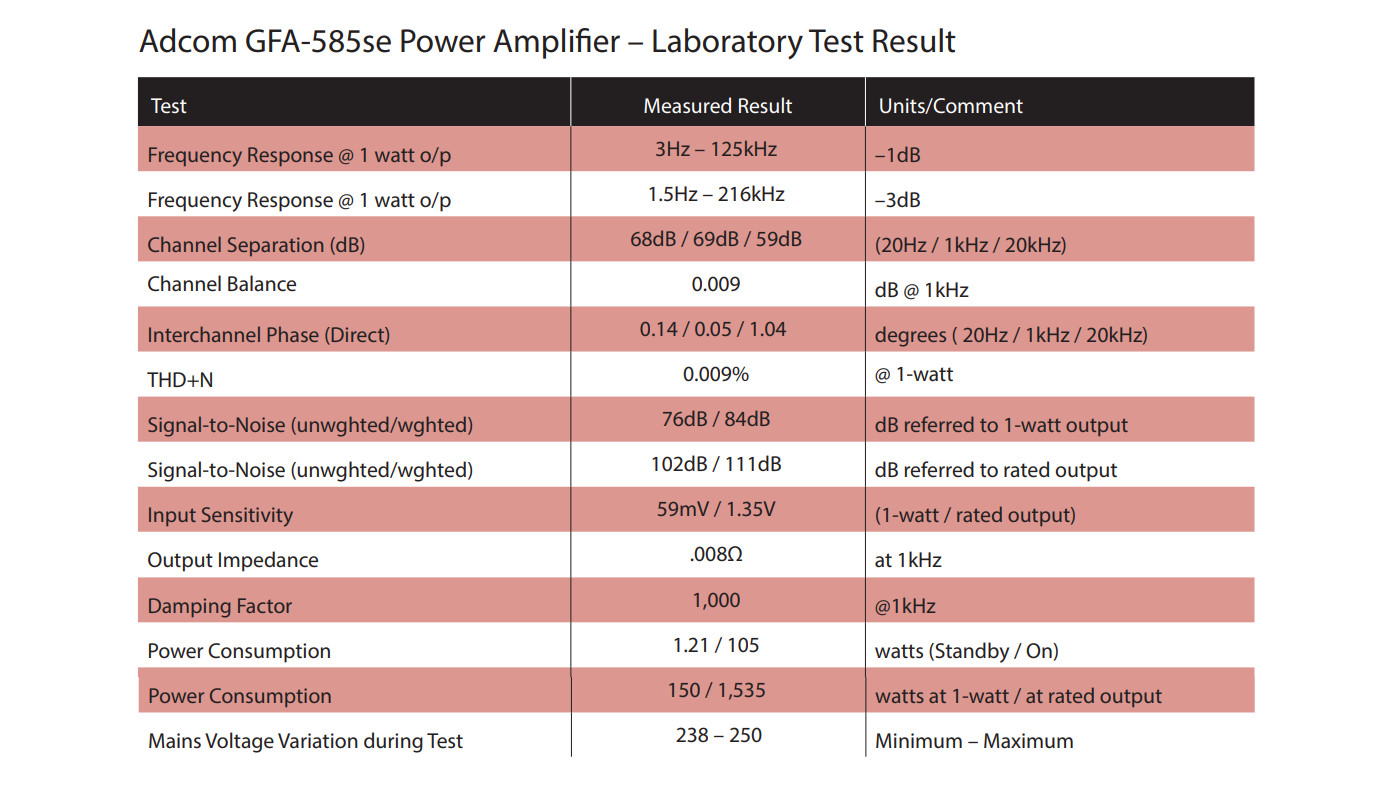
Channel separation was not particularly high, with Newport Test Labs measuring it as 68dB at 20Hz, 69dB at 1kHz and 59dB at 20kHz. While not high, this degree of separation is more than you’ll need to deliver perfect channel separation and stereo imaging. Channel balance was outstandingly good, with just a 0.009dB difference in gain between the two channels, which will also help ensure perfect stereo imaging.
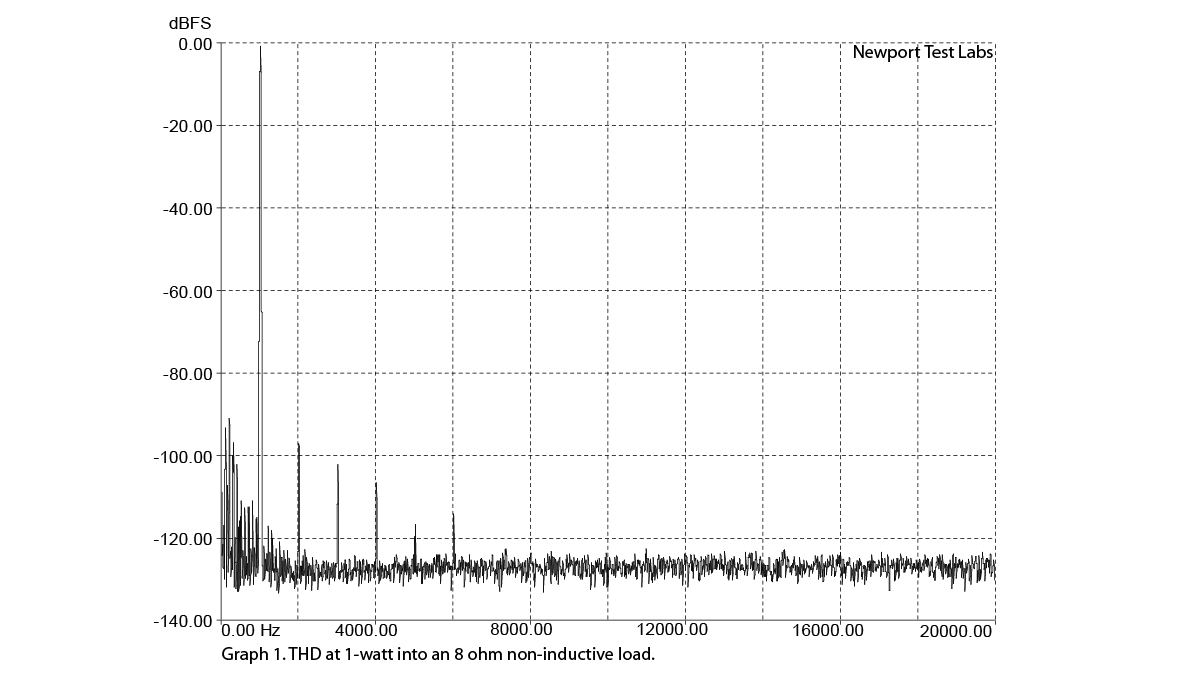
Graph 1 (above) shows the output spectrum of the Adcom GFA-585se when driven by a 1kHz test signal at an output of one watt into an 8Ω load. The test signal is the peak referenced to 0dB at the left of the graph. You can see that there’s a second harmonic distortion component to its right at –97dB (0.00141%), a third harmonic at –103dB (0.0007%), a fourth at –107dB (0.00044%), a fifth at –118dB (0.00012%) and a sixth harmonic at –115dB (0.00017%). All these distortion components are too low to be audible.
You can see that there are some signals to the left of the test signal which are noise from the mains power supply at 50Hz, along with some harmonics of that noise. All these noise components are more than 90dB down. You can see that the overall noise floor across the audio spectrum is otherwise uniform, and close to 130dB down, which is excellent.
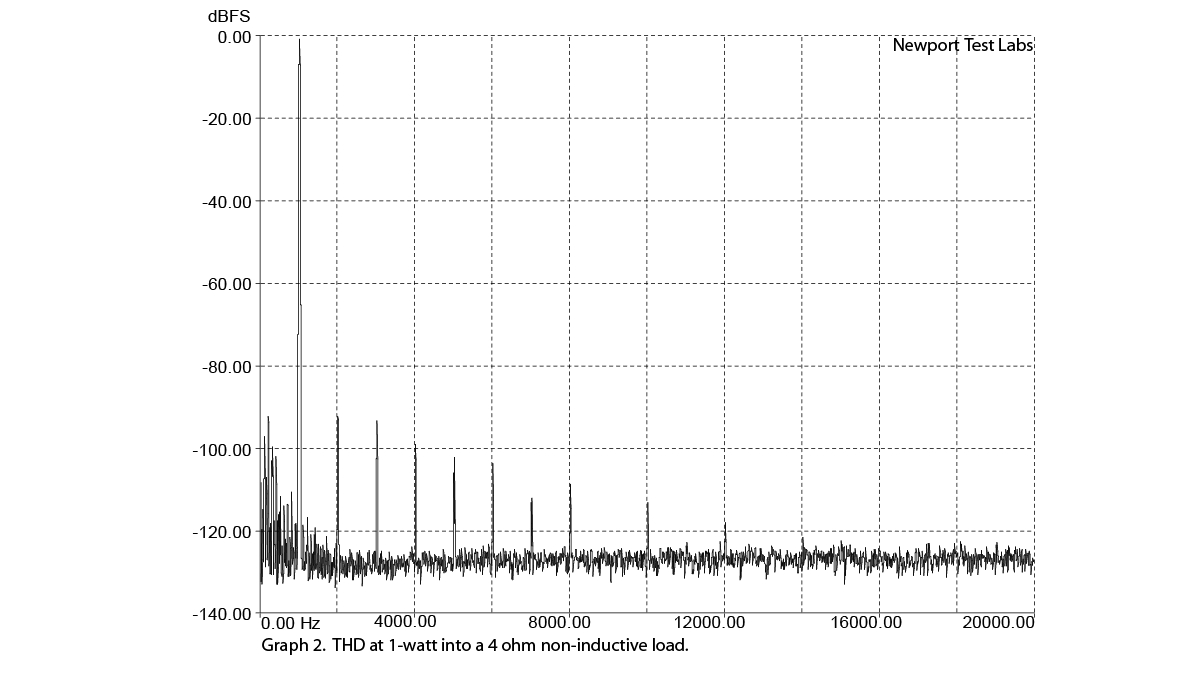
Graph 2 shows performance with a 1kHz test signal at one watt output, but this time into a 4Ω load. You can see that there are now more distortion components visible, and that they’re a little higher in level, but all are so low in level that they would not be audible. The second and third harmonics are both around –94dB (0.00199%), the fourth is down at –100dB (0.001%), and the fifth and sixth harmonics are both around –103dB down (0.0007%). The remaining four distortion components are all more than 110dB down (0.00031%).
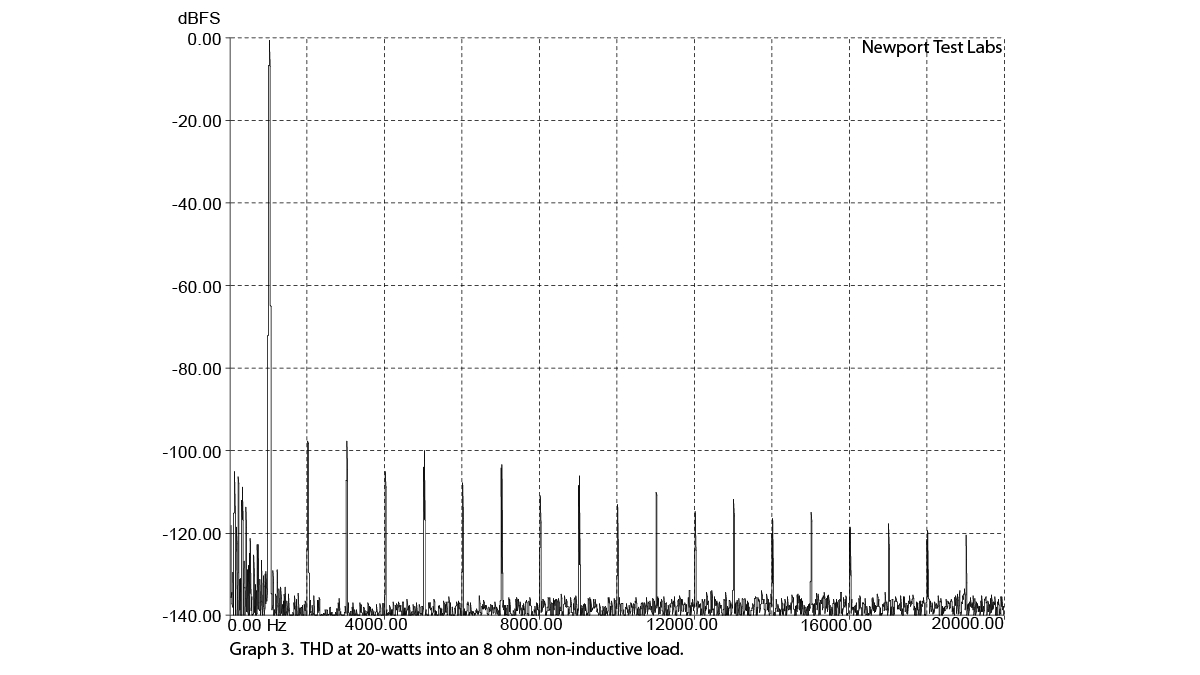
Graph 3 shows performance with a 1kHz test signal and an 8Ω load, but at an output of 20-watts. As you’d expect with the higher output power, distortion has increased again, both in the number of distortion components and level. However, all distortion components except the second and third harmonics, which are both at around –98dB (0.00125%) are more than 100dB down (0.001%) and most are more than 110dB down (0.00031%). So once again, these levels would not be audible.
Note that the noise floor has dropped down close to –140dB across the audio spectrum and that the mains noise at the extreme left is lower in relation to the level of the test signal, which although at 20-watts has now been re-referenced to 0dB.
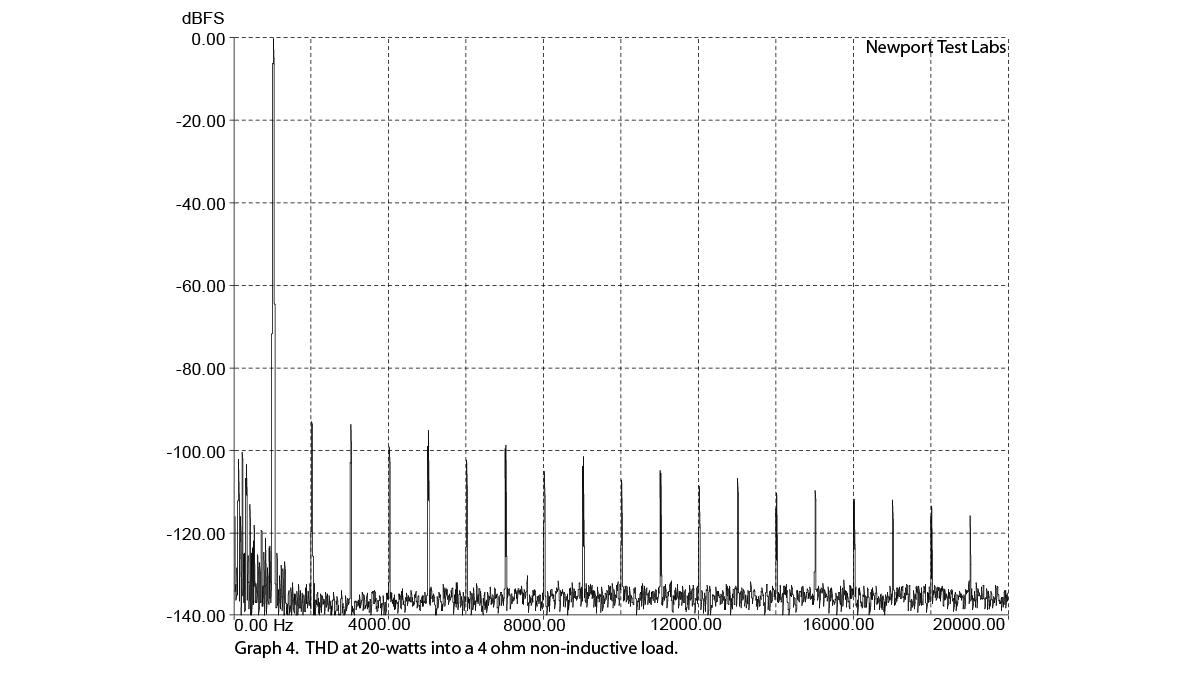
Distortion into a 4Ω load at an output of 20-watts is shown in Graph 4 and you can see that although it’s slightly higher than it was into the 8Ω load at the same power output, it’s essentially the same signature, which is an excellent trait.
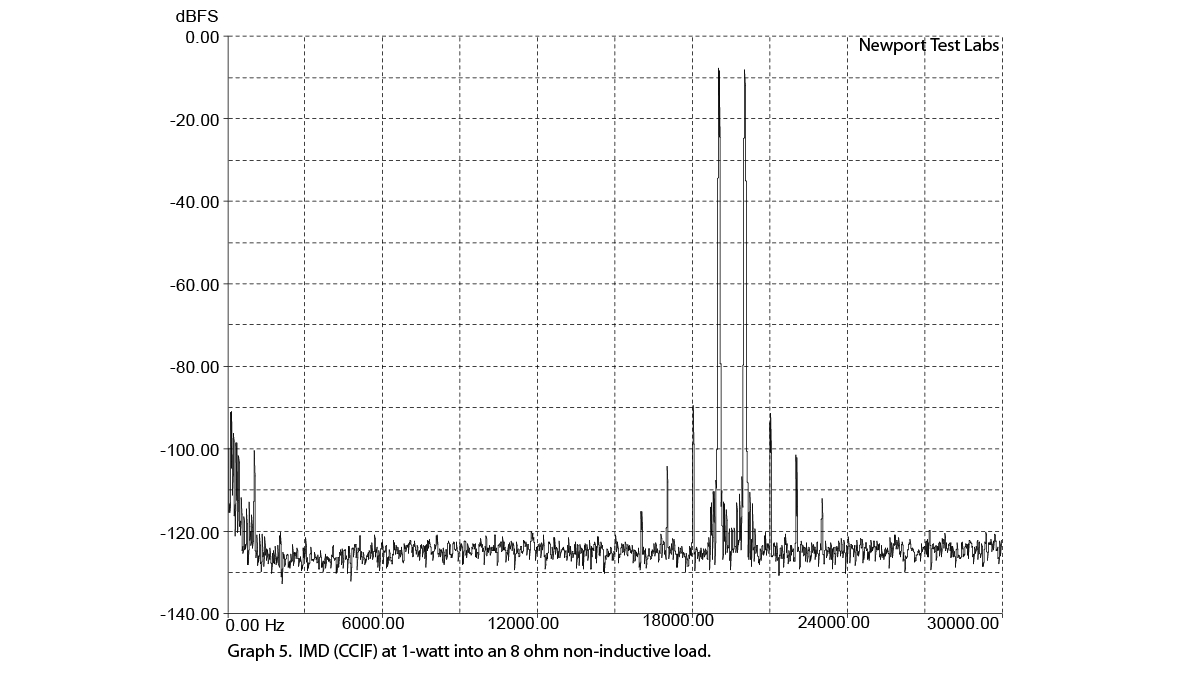
Intermodulation distortion is shown in Graph 5 for an output power of 1-watt into 8Ω. The two test signals (at 19kHz and 20kHz) have upper and lower sidebands at 18kHz and 21kHz both of which are around 90dB down (0.00316%). There are two more sideband pairs, with the higher in level of the two coming in at more than 100dB down (0.001%) and the lower in level at more that 110dB down (0.00031%).
On this graph you can see mains noise at the extreme left of the graph while at 1kHz there’s a regenerated signal that is the difference of the two test signals. It’s sitting at around –102dB, so would not be audible.
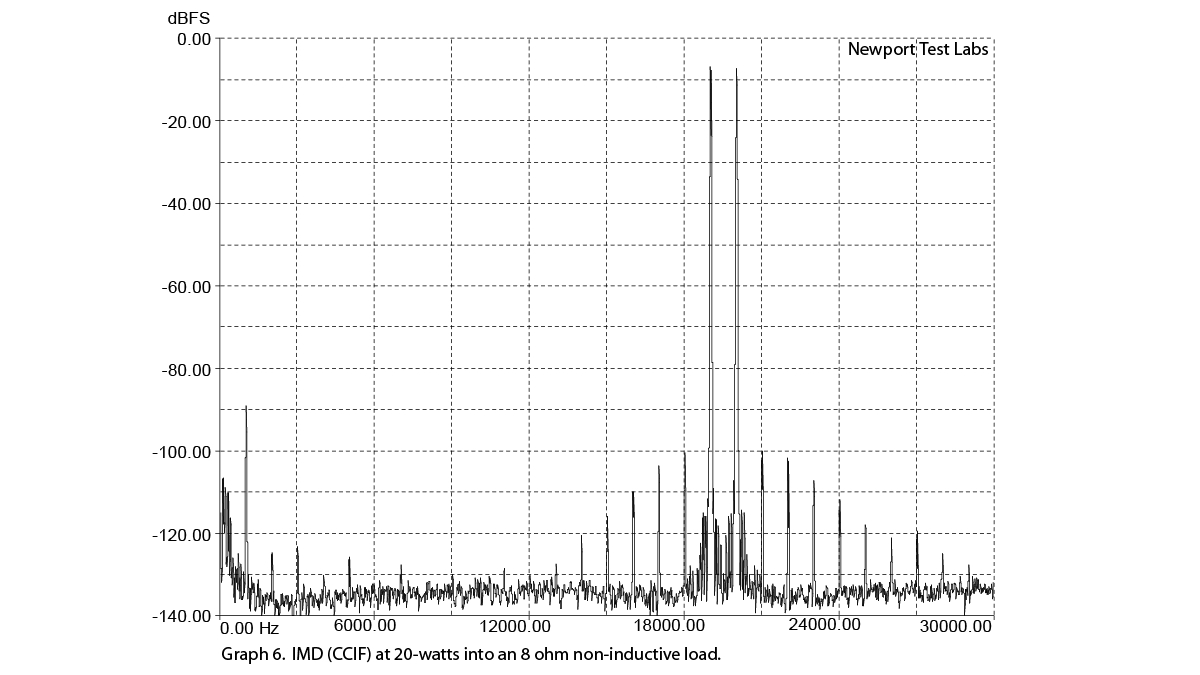
CCIF intermodulation at an output of 20-watts is shown in Graph 6. This time all the higher sidebands are more than 100dB down, but the 1kHz difference signal has increased a little in level, to –98dB (0.00125%). You can see that the noise floor has dropped down close to –140dB. There are some low-order distortion components associated with the difference signal, but all are more than 125dB down (0.00005%).
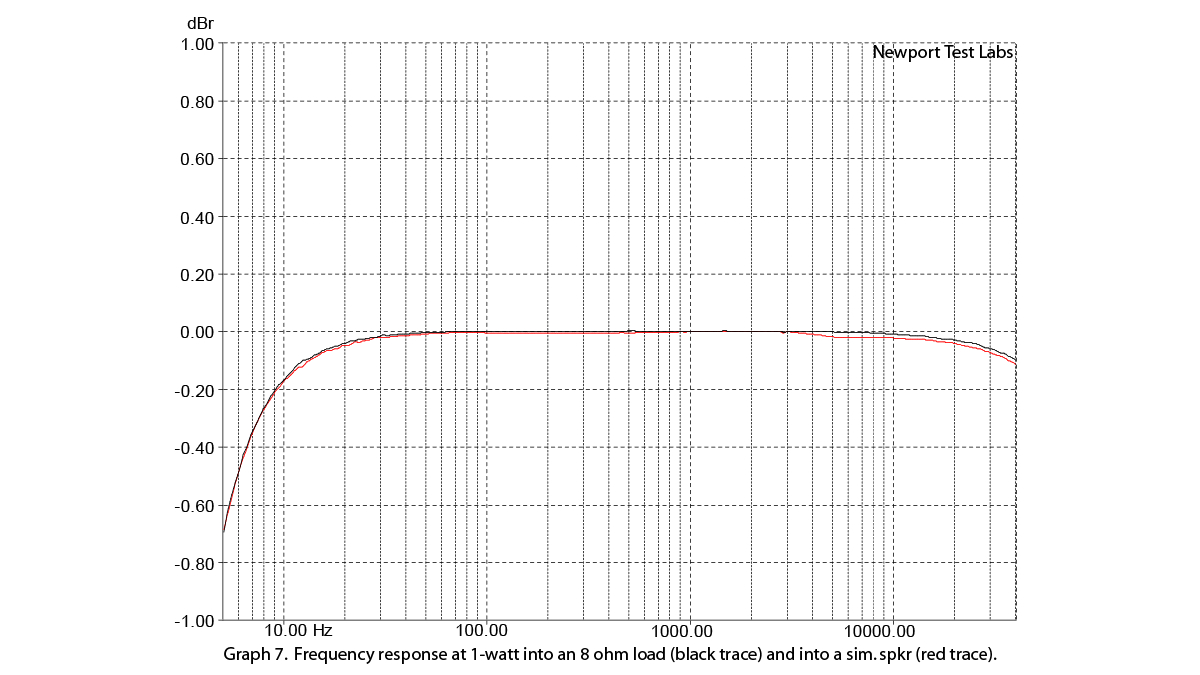
Graph 7 shows the frequency response of the Adcom GFA-585se between 5Hz and 40kHz, using a highly magnified vertical scale, so the top of the graph represents +1dB and the bottom –1dB. There are two traces on the graph. The black trace shows the Adcom’s response when it’s driving an 8Ω non-inductive resistor, which is a standard laboratory test load.
The red trace on the graph shows the Adcom’s frequency response when the amplifier’s output is loaded by a circuit that simulates that which would be presented by a two-way, bass-reflex loudspeaker. It’s the same load used by Stereophile magazine, which is a modified version of an amplifier test load originally developed by Ken Kantor.
You can see that at low frequencies, the traces are virtually overlaid and are 0.65dB down at 5Hz and about 0.05dB down at 20Hz. The traces diverge very slightly above 2kHz, but the differences are really only visible because of the graph scaling. You can see that both responses are about 0.1dB down at 40kHz. This puts the normalised response across the audio band at 20Hz to 20kHz ±0.002dB, which is extraordinarily flat.
When Newport Test Labs looked further at the frequency response, it measured the 1dB down-points of the Adcom GFA-585se’s frequency response as 3Hz and 125kHz, and the 3dB down-points at 1.5Hz and 216kHz. All these results are far better than specification and prove that the Adcom has both a flat frequency response and a very extended one.
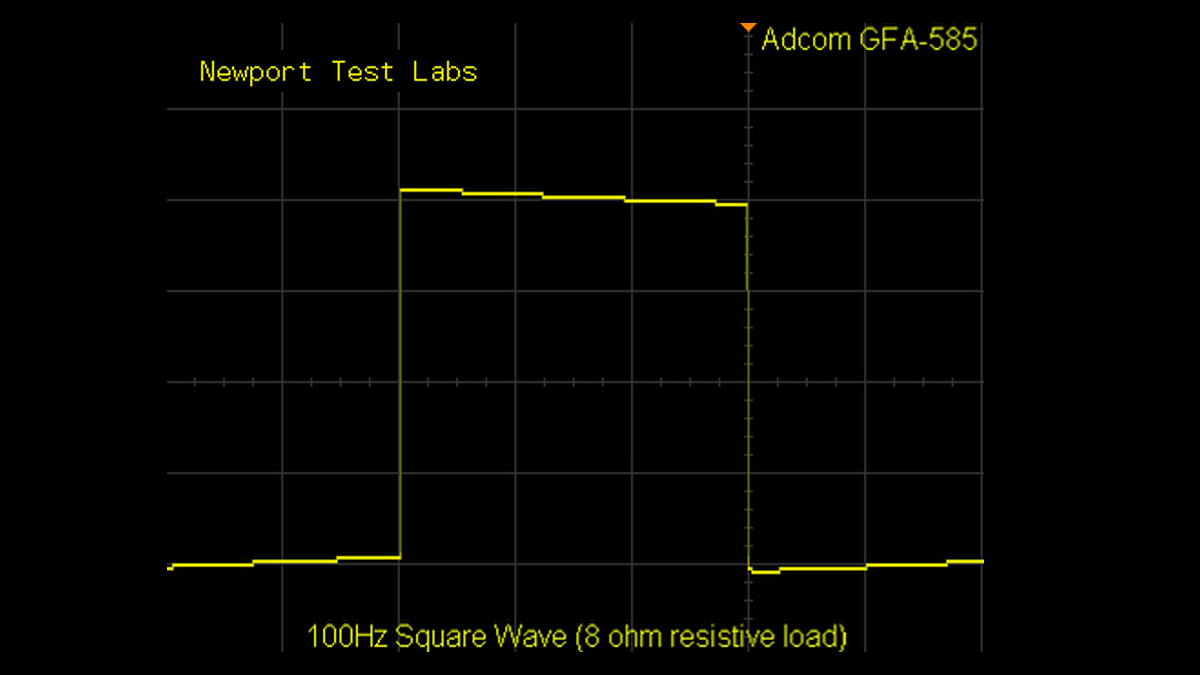
These characteristics are reflected in the square wave responses measured by Newport Test Labs. The 100Hz square wave shows some tilt, which reflects the frequency response being 3dB down at 1.5Hz, but there is no bending that would indicate a phase error. (The ‘stepping’ in the oscillogram is due to the digital oscilloscope itself and should be ignored.)
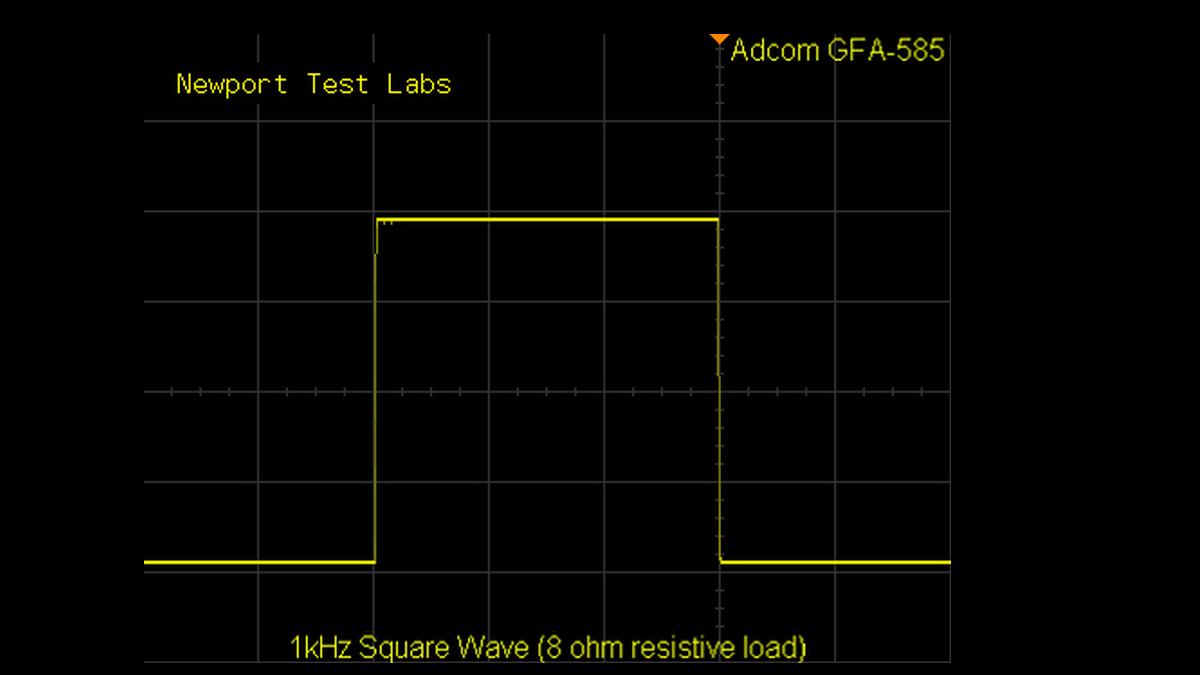
The 1kHz square wave is an almost-perfect representation of the signal from the square wave generator itself. In the oscillogram above you can see a completely vertical leading edge (the glitch near the top is an artefact of the digital oscilloscope) and a perfectly flat top on the waveform. Perfect!
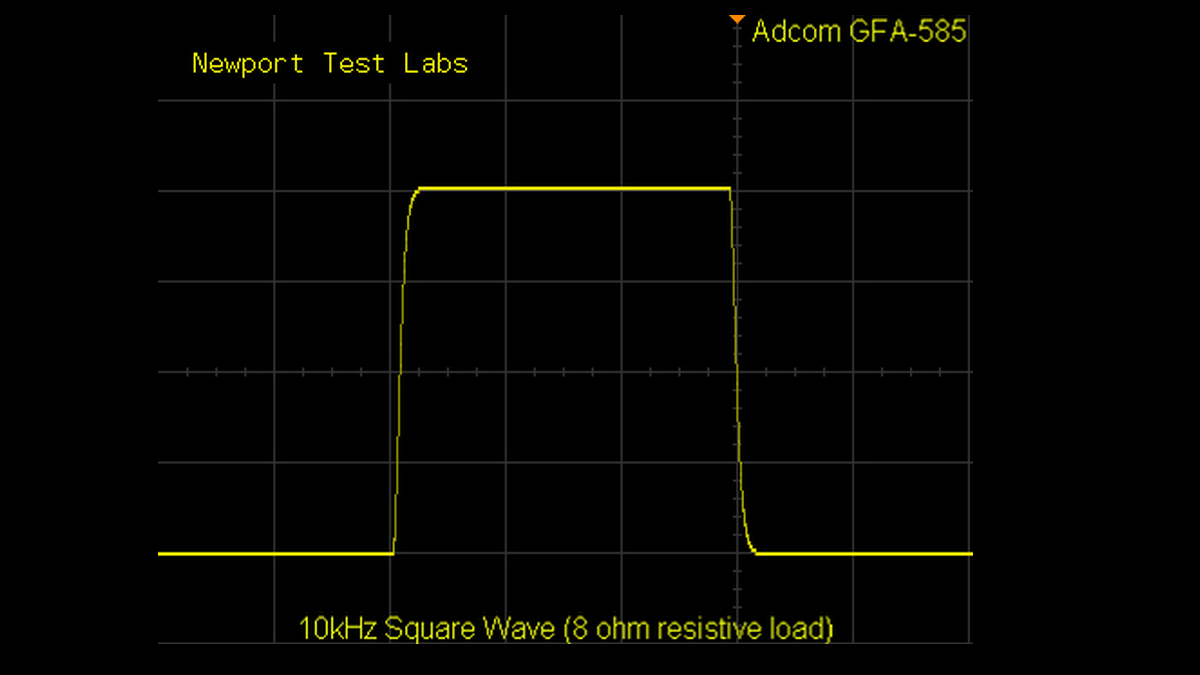
The 10kHz square wave shows the vertical leading edge starting to move away from the vertical as it rises, which shows that the high-frequency response starts rolling off at 125kHz and is 3dB down at 216kHz. It’s an excellent result.
Newport Test Labs would normally show an amplifier’s response when driven by a 1kHz square wave and the speaker terminals connected to an 8Ω resistor in parallel with a 2µF capacitor, which is a very extreme, highly capacitative load.
The Adcom GFA-585se proved to be unstable into this load, so this test was discontinued. As a result I would not recommend the amplifier for use with electrostatic speakers. It will be stable into conventional dynamic speakers, as evidenced by its excellent performance into exactly such a load in Graph 7 (red trace).
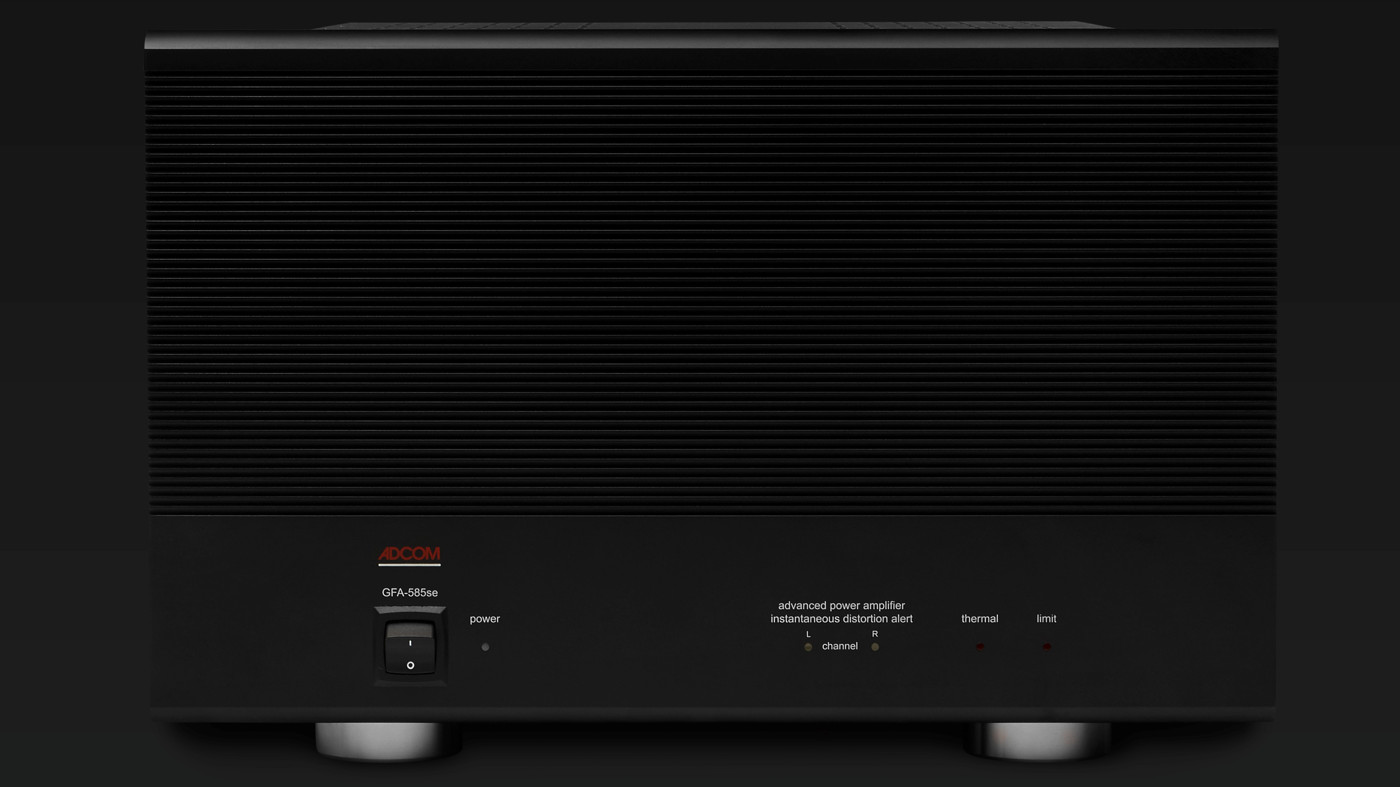
The Adcom GFA-585se’s signal-to-noise ratios were good, as you’d expect from the noise floors returned in the THD and IMD tests, with Newport Test Labs measuring 76dB unweighted and 84dB A-weighted referred to an output of 1-watt, and 102dB unweighted and 111dB A-weighted referred to rated output. The differences between the weighted and unweighted figure suggested to me that there was some noise being introduced by the test set-up, but the 84dB A-weighted result shows that noise will not be audible even at low listening levels.
Newport Test Labs measured the output impedance of the Adcom GFA-585se at 0.008Ω which is an outstandingly good but not unexpected result, given the similarity in the frequency responses when driving a resistive load vs. a reactive one. It results in an extremely high damping factor of 1,000, and means the amplifier will exert control over loudspeaker cones to prevent unwanted inertial movement.
Power consumption was a little higher than one-watt in standby mode, increasing to 105-watts when the amplifier is switched on but with no audio signal present. Once an audio signal is present, the GFA-585se will draw around 150–300 watts when played at normal listening levels, increasing to over 1,500-watts if you were playing it at its maximum output level.
Other than its performance into a highly reactive load, the Adcom GFA-585se returned outstandingly good performance in all the tests conducted by Newport Test Labs.
Australian Hi-Fi is one of What Hi-Fi?’s sister titles from Down Under and Australia’s longest-running and most successful hi-fi magazines, having been in continuous publication since 1969. Now edited by What Hi-Fi?'s Becky Roberts, every issue is packed with authoritative reviews of hi-fi equipment ranging from portables to state-of-the-art audiophile systems (and everything in between), information on new product launches, and ‘how-to’ articles to help you get the best quality sound for your home. Click here for more information about Australian Hi-Fi, including links to buy individual digital editions and details on how best to subscribe.
